This article was first published in Empire magazine issue #27 (September 1991).
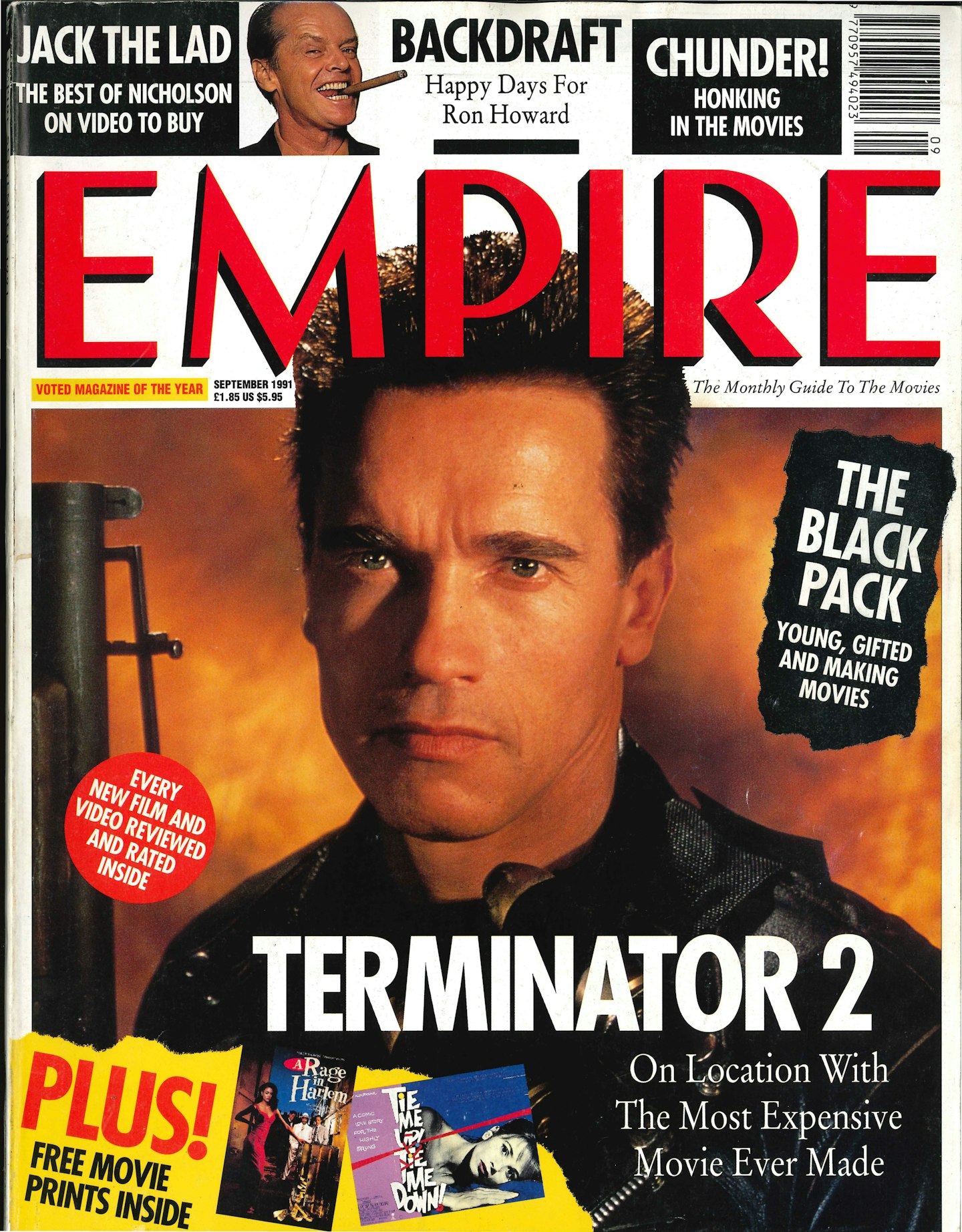
The biggest movie star in the world sits in his dressing room – a trailer bigger than the average American homestead – and chomps on a not inexpensive cigar. What sounds suspiciously like Austrian folk music is piped into the trailer located here at the back of one of the many cheap warehouses to be found in the quiet suburb of Valencia, a sleepy little pocket located just over an hour's drive out of central Los Angeles. A book entitled The Complete Real Estate Sales Guide sits on the coffee table in the middle of the trailer. On the bookshelf opposite sits an obviously fake million-dollar note, a typical in-joke for its owner, to whom the real thing must now seem like so much loose change. Indeed, were it not for the fact that half his face has been blown away, Arnold Schwarzenegger would appear to be in very good shape.
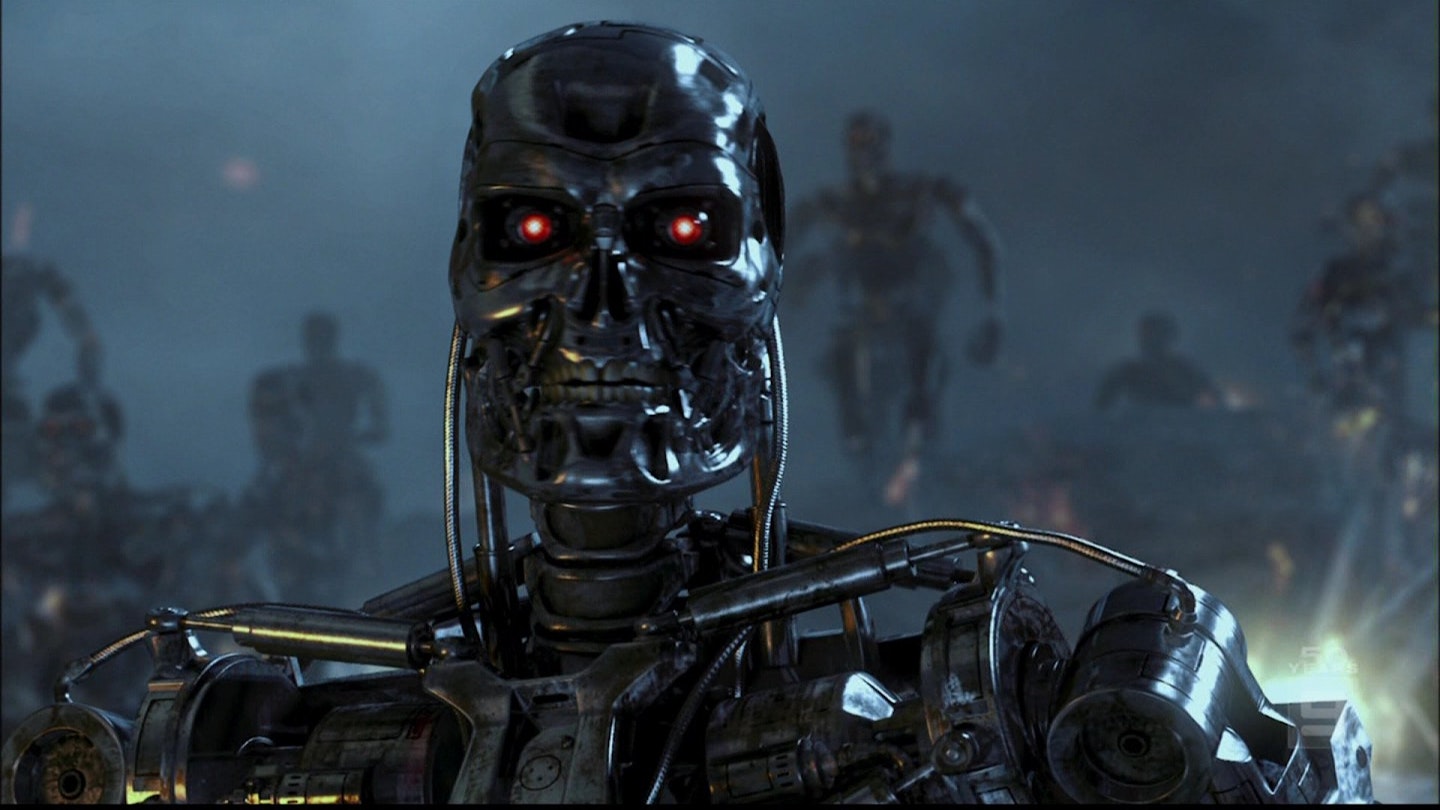
On closer inspection, the damage to the great man extends beyond just the loss of half a face: bullet marks riddle his neck and head; a steel skeletal frame protrudes through half of his face and stomach; one eye is entirely covered over with an elaborate special effects eyeball, enabling it to light up at will; and, clasped around the cigar, there is now some sort of steel contraption where Arnie's left hand used to be.
The reason for the damage is, of course, Terminator 2: Judgment Day, the genuinely eagerly-awaited sequel to 1984's The Terminator – perhaps the major cult hit of the 80s and the film which first launched Schwarzenegger on the road to the extraordinary global success he now enjoys. The main difference now is that Arnie is the hero, the basic T-800 Terminator model programmed to do good works in his battle against the more sophisticated T-1000 machine, a quite remarkable invention capable of taking on any shape with which it comes into contact. At first glance, Arnold would appear to be taking a bit of a beating.
I feel sorry for the movie industry. From this movie on, they're going to be screwed, right?
"I like my friends to come by when I look like this," he chuckles, puffing on the cigar. "I took photos like this with my daughter (two-year-old Katherine Eunice from his marriage to Kennedy clan member Maria Shriver), and she laughed her head off at daddy with all the fake blood. I like to put the photos up on my office wall to shock everybody."
It is certainly not difficult to believe that for Terminator 2, Arnold has had to spend literally hundreds of hours going through the rigours of modern make-up. What is surprising is that this notoriously impatient man seems quite happy to do it.
"For the original film, he was in 'ripped-apart face' make-up for maybe three days," says chief make-up artist Jeff Dawn. "On this film he's in it for maybe 30 days and it takes about five hours to put it on every day and another hour to take it off. And one thing Arnold says he doesn't like about himself is that he isn't patient enough, but I found him to be extremely patient in the chair. He signed the contract to do this movie and read the script and knew he'd be in the chair for hundreds of hours and I've heard no complaints."
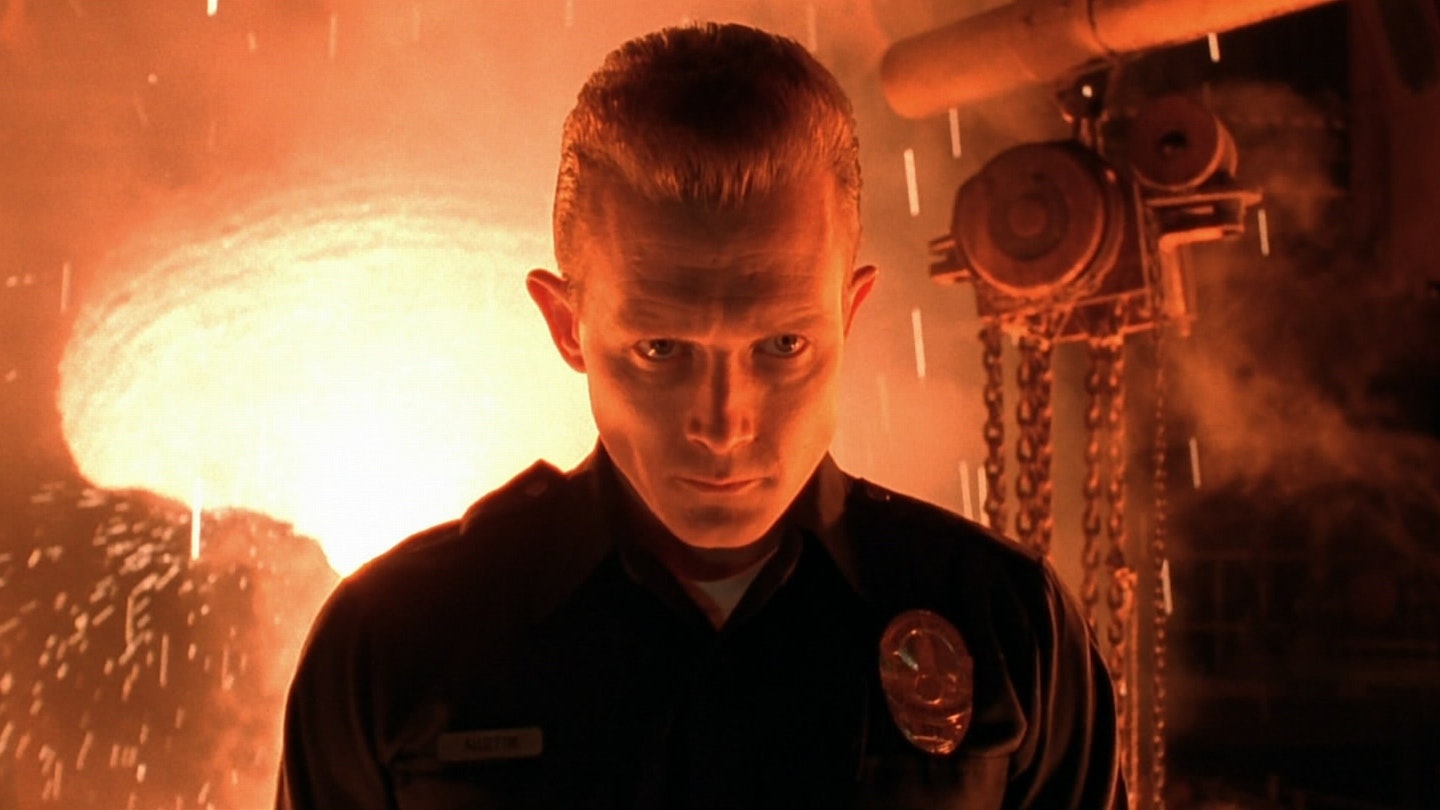
The key change between this sequel and the 1984 original is the fact that this time around Arnie is not so much the bad guy as an underdog to Robert Patrick's more sophisticated T-1000 model Terminator, a killing machine out to destroy ten-year-old John Connor (newcomer Edward Furlong), the future leader of the rebel forces. Arnie's original T-800 is now reprogrammed not to terminate, but to actively protect the boy, son of old adversary Sarah Connor (Linda Hamilton). Even director James Cameron admits that the idea of Arnold Schwarzenegger as underdog is not the easiest notion to accept. Hence the meticulously planned incomplete plot details announced to the world at various points during production.
"We wanted to slowly release the ideas so they built in proper sequence," explains the 37-year-old director, here returning to the scene of his original triumph, having passed by Aliens and The Abyss along the way. "If it just got dumped on you that Arnold was the good guy in this movie, I don't think you'd buy the idea. First, we announced that it was Terminator 2, then that Arnold was reprising the character from the same model line. Then the idea that he has been reprogrammed to be essentially a hero and that there is a second terminator he is in conflict with."
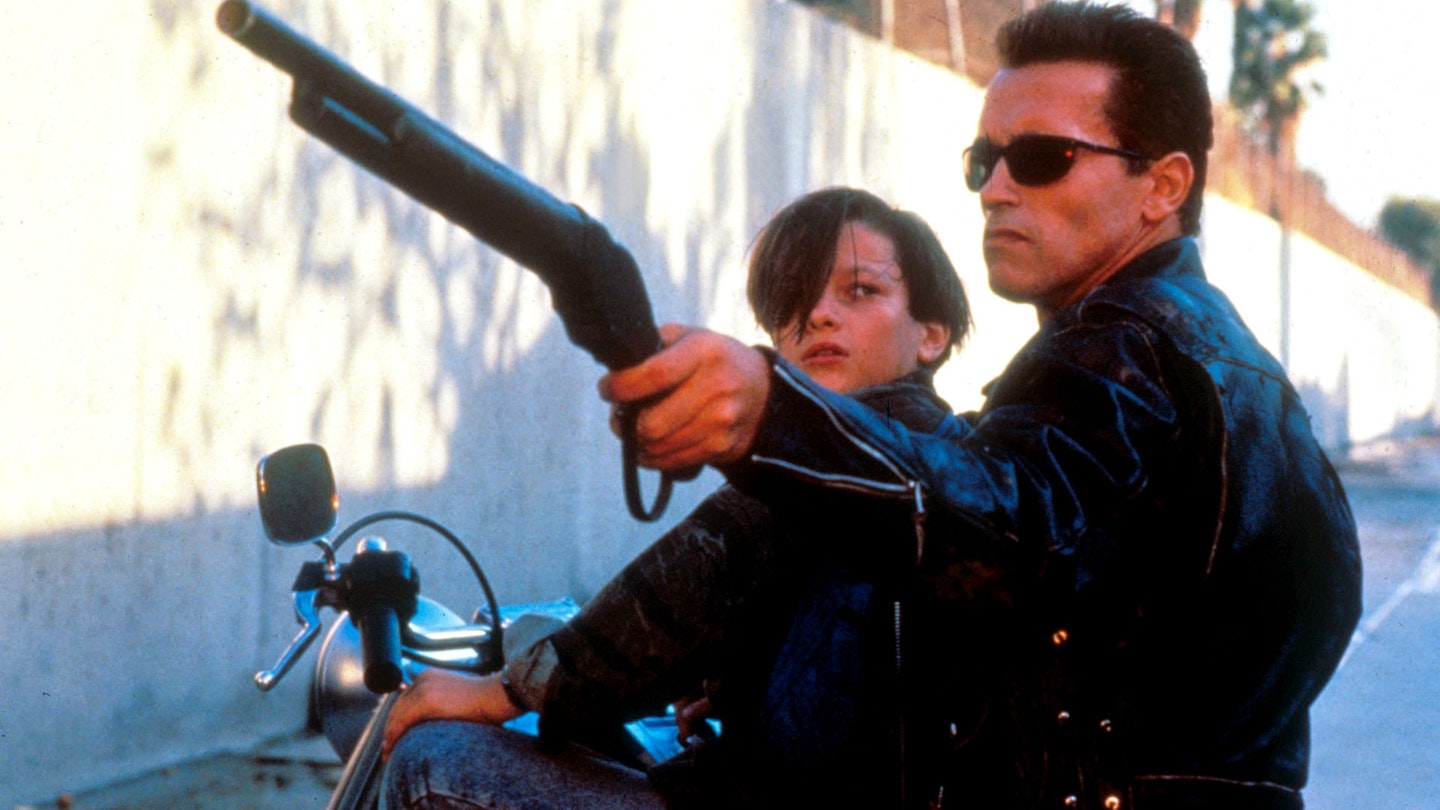
This second terminator, made of liquid metal and the machine that provides the lion's share of Terminator 2's stunning effects, was born out of the obvious need to create something with the terrible capacity of actually scaring the original Terminator, supposedly the ultimate killing machine.
"If I was going to put Arnold on the run," chuckles Cameron, "it had to be something that made us scared for him, so it obviously had to be something so outrageous."
And outrageous it most certainly is, with the computer-generated imagery involved so complex that one 15-second shot could take anything up to ten days for the computer to render on film, while, to produce the required 150 visual effects shots, four different teams of state-of-the-art experts were brought on to the production, including original Terminator creator Stan Winston and the legendary George Lucas outfit, Industrial Light And Magic.
Fortunately for Cameron, his leading man immediately declared himself thrilled with this notion of a new caring, sharing Terminator.
"I read the script last year on the way to Cannes," recalls Schwarzenegger, "and I was very pleased with the twist and the idea of making the Terminator not kill anybody and become more of a human being. It added a great touch of sensitivity and sweetness to the whole movie."
All of which, of course, fits neatly into the real-life transformation of Arnie in the last few years from muscle-bound knucklehead to the family man involved with President George Bush's Council On Physical Fitness. "At the time when The Terminator came out," notes Cameron, "it was fine for Arnold to play an absolute lethal cold-blooded killer. Now, though, we're seven years later, Arnold's role globally has changed and he is a great idol to children and people everywhere. I think it's very fortunate for me that the story that I came up with many years ago involved a change of the character of The Terminator to where he is now essentially the hero of the film."
Cameron acknowledges, however, that getting all the elements together to even attempt a sequel was not the easiest of tasks. "Different people owned the rights, people who weren't getting along," he admits, a diplomatic reference to his now ex-wife, Gale Anne Hurd, co-owner of the rights to the whole Terminator concept with Cameron and Hemdale Films and credited as co-executive producer on the sequel. "It took the intervention of Mario Kassar (co-founder of industry heavyweights Carolco Pictures) to come in and purchase the rights from the individuals who owned them, different parts of it, and put it all together."
While smoothing the way for the sequel to actually get made, this sudden intervention from the deep pockets of Carolco – Hemdale and Hurd being bought out for a reported $5 million apiece – was the first signal that Terminator 2 was on its way to major-budget status. The alleged $15 million payment to Arnie and Cameron's own fee quickly set the film on its way to a price tag close to $100 million and the unwanted title of The Most Expensive Movie Ever Made. And while, understandably, no-one at Carolco is prepared to reveal the actual budget – the general consensus now settles at $88 million – James Cameron is ready and willing to defend the money spent.
"I don't think of it as one of the most expensive films ever made," explains Cameron, "because I only think of it as the amount of money that I've been given to actually make the movie. That's the below-the-line budget and that's healthy but not comparable to some of the top ten films. And the point is that large-scale action films with special effects cost money. The scrutiny about the budget doesn't bother me so long as people look at the film and what the film is about and don't review the budget. Then I'll be happy."
Schwarzenegger simply sidesteps the entire question of money. "All I know," he hedges, "is that this has to be a very expensive movie because of what he have shot for five and a half months. We have used technology that has never been used before and everything is very sophisticated. Yet, as a businessman, I see that the bottom line is looking at what something costs and then always looking at how much money can I make with what I have spent. You can spend one dollar and make three dollars back. Or I can spend $300,000 and make $3,000,000 back. It doesn't matter. It's all zeros and the important thing is that we have to be responsible for making the money back or making it back twice or ten times over."
This classic example of the 90s actor/marketing man/businessman breaks into a delicious grin as he details the tactics used to finally win over the rights to the sequel. "It was always thought that this was the perfect vehicle for a sequel," he explains, "but all those years it was tied up at Hemdale. So it was just a matter of time to wait for the vulnerable spot of Hemdale, which we knew would happen eventually, and then rush in and get back the movie. That's how we got Total Recall away from Dino (Di Laurentiis) and so that's what you do – you just wait for your turn and if something is good enough, well, it's worth waiting for."
Now, nearly six months on, the calm confidence of Cameron and Schwarzenegger certainly seems justified, with Terminator 2 wiping up the opposition and already through the $100 million mark after just two weeks on release. And even those critics who may find the storyline lacking the radical edge of the 1984 original have been universally swept away by the extraordinary effects involved with the liquid T-1000, a huge leap from Cameron's first attempt in this field, the pseudo-pod resembling Mary Elizabeth Mastrantonio's face on the end of a swirling tunnel of water in The Abyss.
"We found out with The Abyss that it was a viable process and could be done on schedule and for a known amount of money without a lot of drama," he explains. "So I called and asked the people at Industrial Light And Magic just how far I could go on this one. I had some ideas and I really wanted to push the envelope. In The Abyss, if that scene hadn't worked, I could just take it out. In Terminator 2, the big gamble was that I was pinning the dramatic success of a movie on a technique that was unproven. But I just instinctively knew they could do it."
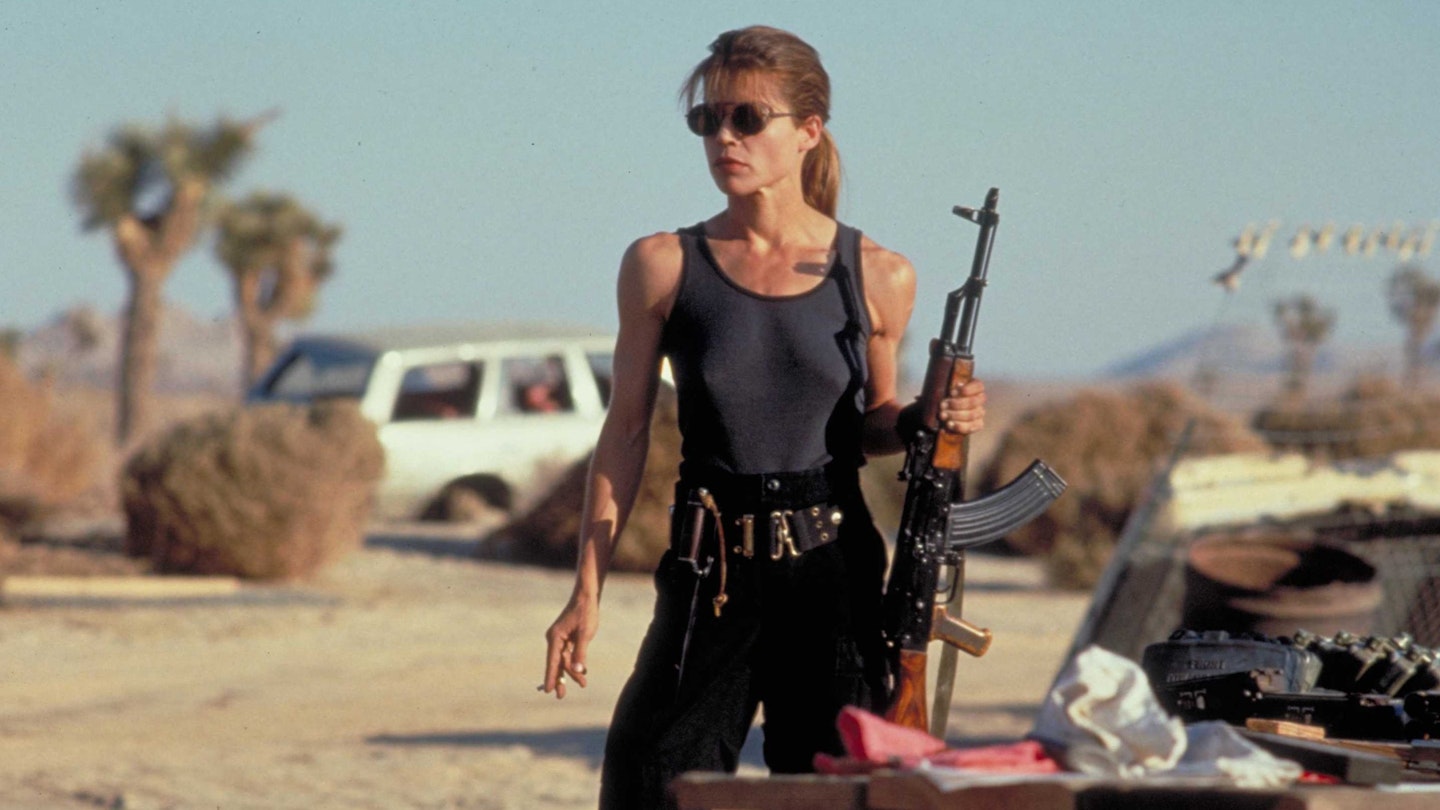
Along with the effects, Cameron's two chief headaches were the sheer expertise required for the movie's spectacular stunts and the crucial US release deadline of July 4, giving him the shortest post-production time in the history of Hollywood. On this point, Cameron simply cut it as he went along.
"With The Abyss," recalls Cameron, "the mistake I made there was because it was so tiring and exhausting to shoot, I didn't do any cutting until it was over. With Terminator 2, post-production started the day after the film began shooting on October 8. I made sure we worked only five days a week so I could work in the cutting room on weekends and we cut the movie as we went along. It's what the astronauts call 'maintaining an even strain' – you just have to not let up, so then you think it's status quo. The second you look down, you realise how high up you are."
For the thrills and spills, stunt co-ordinator Joel Kramer was confronted with a movie that devotes more than 60 per cent of its running time to pure action. "When I read the script," recalls Kramer, "I was champing at the bit. Jim wrote the action down so explicitly detailed that we knew it wasn't action for the sake of having stunts. Everything works for the script." He reels off the more dangerous stunts as, "The 750-pound motorcycle which jumped 60 feet from about 15 feet in the air, a guy on a bike jumping at almost 40 miles an hour out of a second story window into a helicopter, a cannon roll where I flipped a van, and everything from guns being lit on fire to shoot-outs to car chases. It runs the entire spectrum of stunts." And while Kramer is obviously pleased that Arnold was in such great shape that he was able to do "75 to 80 per cent of his own stunts," he does confess that such star involvement did have its drawbacks. "He's such a good athlete," says Kramer, "that we could work a 15-hour day and he'd still ride his life-cycle for an hour before or after work and drag us along. If we had a 30-minute lunch break, he'd say, 'Forget lunch - you're coming to work out with me.'"
The end result of all this ferociously detailed action, planning and huge-budget effects is, then, the biggest movie hit of the summer and the saviour of an otherwise disappointing year so far for the Hollywood honchos. Just, in fact, like they all promised it would be. "The audiences are more sophisticated than they were in 1984," offers make-up maestro Jeff Dawn as production winds down. "They're more educated and have seen the way special effects are done so now they're looking for little extras that make them go, 'Wow, how do they do that?' I can't imagine anybody walking out of the theatre after seeing Terminator 2 saying, 'Well, I didn't see enough, I didn't get enough action or suspense or effects.'"
Larry Kasanoff, Cameron's partner, is equally confident of avoiding a money-back situation. "If theatre-goers come to see a bloodfest of Arnold merely killing people, then they'll be disappointed," says Kasanoff. "If they come for an action film and the best rollercoaster ride of their lives, they'll be thrilled."
Last word to the big man.
"I have to say that I feel sorry for the movie industry in a way," says Schwarzenegger with one of those cocky grins. "Because, from this movie on, they're going to be screwed, right? Where else can they go? This is it. This is the answer and these poor studio executives are sitting out there trying to figure out how to top it. And you know what?" He leans forward to butt out the cigar, metallic hand still hanging off his shoulder. "They can't!"
Terminator 2: Judgment Day is re-released in cinemas in 3D for one night, August 29th.
